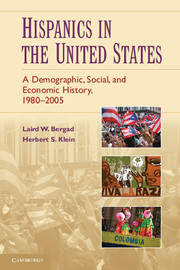Book contents
- Frontmatter
- Contents
- List of Graphs, Tables, and Maps
- Introduction
- 1 Immigration to the United States to 1980
- 2 The Hispanic Population to 1980
- 3 Population Growth and Dispersion, 1980–2005
- 4 The Demography of the Hispanic Population
- 5 Wealth and Poverty
- 6 Educational Attainment
- 7 Citizenship, the Latino Electorate, and Voter Participation
- 8 Occupational Structures, Employment, and Unemployment
- 9 English Language Abilities and Domestic Usage
- 10 Hispanic Business Ownership
- 11 Race
- 12 Endogamous and Exogamous Marriage Patterns among Latino Household Heads
- 13 Conclusion
- Bibliography
- Index
12 - Endogamous and Exogamous Marriage Patterns among Latino Household Heads
Published online by Cambridge University Press: 05 June 2012
- Frontmatter
- Contents
- List of Graphs, Tables, and Maps
- Introduction
- 1 Immigration to the United States to 1980
- 2 The Hispanic Population to 1980
- 3 Population Growth and Dispersion, 1980–2005
- 4 The Demography of the Hispanic Population
- 5 Wealth and Poverty
- 6 Educational Attainment
- 7 Citizenship, the Latino Electorate, and Voter Participation
- 8 Occupational Structures, Employment, and Unemployment
- 9 English Language Abilities and Domestic Usage
- 10 Hispanic Business Ownership
- 11 Race
- 12 Endogamous and Exogamous Marriage Patterns among Latino Household Heads
- 13 Conclusion
- Bibliography
- Index
Summary
One measure of acculturation into the host society among immigrant populations is the changing frequency they choose to marry outside of their particular national, racial, or ethnic groups. The databases we have used throughout this book provide a number of ways to examine changing marriage patterns among Latinos. We have chosen to use data on household heads and their spouses as indicators of shifting marriage choices between 1980 and 2005. These household data are not ideal in that they do not represent marriage patterns among the entire Hispanic population, as there may have been more than one family living within a household. There could have been cross-generational related families or multiple families living in the same household. However, the Census Bureau designated only one person as the head of the household. Despite their imperfections, these data on household heads and their spouses are suggestive of general endogamous and exogamous marriage patterns among the Latino population.
As expected, there were significant differences in marriage patterns when domestic-born Latinos are compared with their foreign-born counterparts. By 2005 roughly 90% of Latino foreign-born household heads, both male and female, married other Latinos, while a significantly lower portion – about two-thirds – of domestic-born Latino household heads of both sexes married other Latinos. (See Table 12.1.) Between 1980 and 2005, the percentage of domestic-born male Latino household heads who married other Latinos fell from 75% to 69%, while there was almost no change in the percentage of female domestic-born Latino household heads who married other Latinos – 65% in 1980 and 66% in 2005. Over the same period there was marginal change in the percentage of male and female foreign-born Latinos who married other Latinos. (See Graph 12.1.) When marrying non-Latinos, most household heads married non-Hispanic whites, and only a very small percentage chose to marry non-Hispanic blacks or Asians. (See Graph 12.2.)
- Type
- Chapter
- Information
- Hispanics in the United StatesA Demographic, Social, and Economic History, 1980–2005, pp. 391 - 405Publisher: Cambridge University PressPrint publication year: 2010



